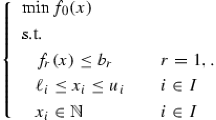Abstract
By now, many copositive reformulations of mixed-binary QPs have been discussed, triggered by Burer’s seminal characterization from 2009. In conic optimization, it is very common to use approximation hierarchies based on positive-semidefinite (psd) matrices where the order increases with the level of the approximation. Our purpose is to keep the psd matrix orders relatively small to avoid memory size problems in interior point solvers. Based upon on a recent discussion on various variants of completely positive reformulations and their relaxations (Bomze et al. in Math Program 166(1–2):159–184, 2017), we here present a small study of the notoriously hard multidimensional quadratic knapsack problem and quadratic assignment problem. Our observations add some empirical evidence on performance differences among the above mentioned variants. We also propose an alternative approach using penalization of various classes of (aggregated) constraints, along with some theoretical convergence analysis. This approach is in some sense similar in spirit to the alternating projection method proposed in Burer (Math Program Comput 2:1–19, 2010) which completely avoids SDPs, but for which no convergence proof is available yet.
Similar content being viewed by others
Notes
IBM ILOG, CPLEX Optimizer. http://www.ibm.com/software/integration/optimization/cplex/.
References
Arima N, Kim S, Kojima M (2014) Simplified copositive and Lagrangian relaxations for linearly constrained quadratic optimization problems in continuous and binary variables. Pac J Optim 10:437–451
Bazaraa M, Shetty CM (1979) Nonlinear programming: theory and algorithms. Wiley, New York
Beasley J (2010) OR-library. http://people.brunel.ac.uk/~mastjjb/jeb/info.html
Bomze IM, Dür M, de Klerk E, Roos C, Quist AJ, Terlaky T (2000) On copositive programming and standard quadratic optimization problems. J Glob Optim 18:301–320
Bomze IM, Schachinger W, Uchida G (2012) Think co(mpletely)positive ! Matrix properties, examples and a clustered bibliography on copositive optimization. J Glob Optim 52:423–445
Bomze IM, Schachinger W, Ullrich R (2015) New lower bounds and asymptotics for the cp-rank. SIAM J Matrix Anal Appl 36:20–37
Bomze IM, Cheng J, Dickinson PJC, Lisser A (2017) A fresh CP look at mixed-binary QPs: new formulations and relaxations. Math Program 166(1–2):159–184
Burer S (2009) On the copositive representation of binary and continuous nonconvex quadratic programs. Math Program 120:479–495
Burer S (2010) Optimizing a polyhedral-semidefinite relaxation of completely positive programs. Math Program Comput 2:1–19
Burer S (2015) A gentle, geometric introduction to copositive optimization. Math Program 151:89–116
Burkard RE, Karisch SE, Rendl F (1997) QAPLIB—a quadratic assignment problem library. J Glob Optim 10(4):391–403
Dickinson PJC (2010) An improved characterisation of the interior of the completely positive cone. Electron J Linear Algebra 20:723–729
Dickinson PJC (2013) The copositive cone, the completely positive cone and their generalisations, Ph.D. thesis. University of Groningen
Dickinson PJC, Gijben L (2014) On the computational complexity of membership problems for the completely positive cone and its dual. Comput Optim Appl. 57(2):403–415. https://doi.org/10.1007/s10589-013-9594-z
Grant M, Boyd S (2008) Graph implementations for nonsmooth convex programs. In: Blondel V, Boyd S, Kimura H (eds) Recent advances in learning and control (a tribute to M. Vidyasagar), Lecture Notes in Control and Information Sciences. Springer, Berlin, pp 95–110. http://stanford.edu/~boyd/graph_dcp.html
Grant M, Boyd S (2013) CVX: Matlab software for disciplined convex programming, version 2.0 beta. http://cvxr.com/cvx
Kiwiel KC (1983) An aggregate subgradient method for nonsmooth convex minimization. Math Program 27(3):320–341
Murty KG, Kabadi SN (1987) Some NP-complete problems in quadratic and nonlinear programming. Math Program 39(2):117–129
Shaked-Monderer N, Berman A, Bomze IM, Jarre F, Schachinger W (2015) New results on the cp rank and related properties of co(mpletely )positive matrices. Linear Multilinear Algebra 63(2):384–396
Sherali HD, Adams WP (1990) A hierarchy of relaxations between the continuous and convex hull representations for zero-one programming problems. SIAM J Discrete Math 3:411–430
Sturm JF (1999) Using SeDuMi 1.02, a Matlab toolbox for optimization over symmetric cones. Optim Methods Softw 11–12:625–653
Acknowledgements
The authors would like to thank the handling Associate Editors and two anonymous referees for their very useful comments and suggestions which helped to improve our paper significantly. This research benefited from the support of the “FMJH Program Gaspard Monge in Optimization and Operations Research”, and from the support to this program by EDF. Peter J. C. Dickinson would like to gratefully acknowledge support from the Netherlands Organisation for Scientific Research (NWO) through Grant No. 613.009.021.
Author information
Authors and Affiliations
Corresponding author
Rights and permissions
About this article
Cite this article
Bomze, I.M., Cheng, J., Dickinson, P.J.C. et al. Notoriously hard (mixed-)binary QPs: empirical evidence on new completely positive approaches. Comput Manag Sci 16, 593–619 (2019). https://doi.org/10.1007/s10287-018-0337-6
Received:
Accepted:
Published:
Issue Date:
DOI: https://doi.org/10.1007/s10287-018-0337-6
Keywords
- Copositivity
- Completely positive
- Quadratic optimization
- Reformulations
- Nonlinear optimization
- Nonconvex optimization
- Penalization method
- Quadratic assignment problem
- Mul tidimensional knapsack problem




